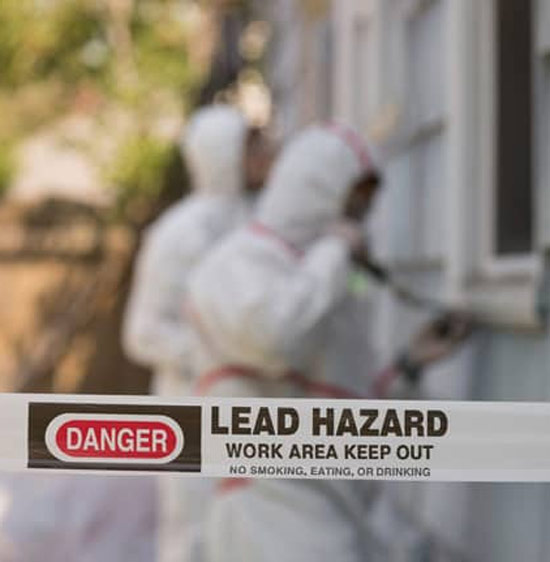Finest Practices for Making Sure Safe and Detailed Lead Violation Reduction
Resolving lead violation reduction requires a multi-faceted strategy to make sure both security and conformity. Preliminary analyses making use of sophisticated discovery methods such as XRF analyzers set the phase for an accurate understanding of contamination degrees. Integrating proper control strategies, consisting of airtight barriers and HEPA filtration, coupled with using individual safety equipment (PPE) for workers, creates the backbone of a safe procedure. Precise clean-up protocols, including HEPA vacuuming and wet-wiping, are vital. It's the last clearance procedure, entailing thorough inspections and laboratory testing, that truly confirms a lead-free environment, ensuring long-term safety. How do these practices adjoin to assure thorough lead reduction?

First Evaluation
Conducting a first evaluation is a vital very first step in lead violation reduction. This phase incorporates an in-depth assessment of the residential or commercial property to identify the existence, extent, and certain locations of lead-based threats. Qualified specialists, such as licensed lead assessors or run the risk of assessors, should do a comprehensive website inspection, making use of tools like X-ray fluorescence (XRF) analyzers to precisely detect and gauge lead concentrations in paint, dirt, dirt, and water.
The evaluation has to also consist of a testimonial of the building's history, previous records, and any problems or wellness issues reported by passengers - Lead Removal Contractors. Recording the findings thoroughly is crucial, as these records develop the basis for creating an effective abatement method. A comprehensive evaluation additionally entails sampling and lab evaluation, which are essential to confirm the presence of lead and guide succeeding activities
In addition, it is vital to connect the outcomes transparently to all stakeholders, consisting of homeowner, occupants, and governing authorities. By making sure that the first evaluation is conducted with precision and rigor, professionals can lay a strong structure for a targeted and effective lead abatement process, eventually securing public wellness and making sure compliance with regulative requirements.
Proper Control
Correct containment is essential to prevent the spread of lead impurities during reduction activities. Effectively taking care of containment minimizes the threat of lead dust and particles migrating to non-work locations, consequently protecting both the setting and people outside the immediate job zone.

Regular assessments of the containment location are necessary to examine for breaches or weak points in the barrier. Any type of recognized problems need to be quickly resolved to preserve the honesty of the containment. By sticking to these techniques, abatement tasks can effectively manage lead contamination and mitigate involved wellness risks.
Employee Defense
Guaranteeing employee defense is paramount throughout lead reduction projects to stop job-related exposure to dangerous lead fragments. Important measures include the usage of individual safety equipment (PPE) such as respirators, gloves, and full-body fits especially designed to block lead dust and fumes. Workers must undertake comprehensive training on the appropriate usage and upkeep of PPE, consisting of healthy screening for respirators to ensure maximum efficacy.
Engineering controls, such as regional exhaust ventilation systems, are vital in decreasing air-borne lead focus in the workplace. Administrative controls should also be executed, including limiting the duration of exposure and rotating workers to decrease private direct exposure great site times. Routine clinical surveillance and organic surveillance are vital for early detection of lead absorption, enabling prompt treatment and treatment.
In addition, establishing a decontamination method is essential. Employees have to adhere to rigid decontamination procedures before breaks and at the end of their change to avoid lead dirt from being brought outside the workplace. This consists of thorough hand and face cleaning with lead-specific cleansing agents and changing out of infected garments.
Careful Cleanup
Maintaining a secure workplace extends past employee security and encompasses thorough clean-up to guarantee lead fragments are extensively eliminated from the website. The procedure of precise cleaning is important in stopping the this website recontamination of the abated location and securing both current and future owners.
To accomplish a comprehensive clean-up, all work locations must be methodically decontaminated. This includes using specialized HEPA (High-Efficiency Particulate Air) vacuum cleaner cleaners and wet-wiping methods to capture and eliminate great lead dust that might have picked surface areas. It is crucial to clean all straight surface areas, including floorings, window sills, and counter tops, along with vertical surface areas that might have caught lead fragments.
Workers need to put on suitable individual protective devices (PPE) throughout cleanup to prevent direct exposure to residual lead dust. Made use of cleaning materials such as wipes, sponges, and wipe heads need to be gotten rid of in conformity with hazardous waste disposal policies.

Last Clearance
Last clearance is the vital concluding phase of lead abatement that determines whether the site is safe for reoccupation. This crucial step involves extensive evaluation and testing to validate that all lead threats have actually been properly removed.

Final clearance screening not only safeguards future occupants yet likewise makes sure compliance with neighborhood, state, and government policies. In addition, it works as a recorded validation of the abatement service provider's adherence to market best techniques. Ensuring a detailed and successful last clearance is necessary in protecting public wellness and promoting count on the abatement procedure.
Conclusion
Making certain risk-free and thorough lead infraction reduction necessitates a complex method incorporating initial evaluations with innovative detection techniques, effective containment approaches, stringent worker defense protocols, and careful cleaning procedures. The final clearance stage, featuring comprehensive examinations and look at this site laboratory testing, is critical to confirm compliance with EPA criteria. Adherence to these ideal practices ensures a secure setting for residents, alleviates wellness threats, and upholds regulative demands, therefore advertising public health and safety in lead-affected areas.